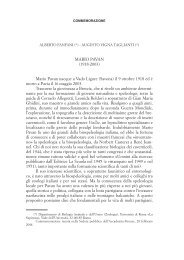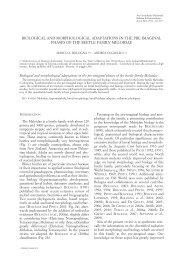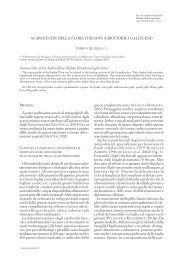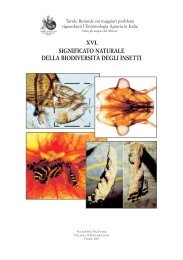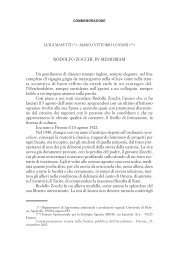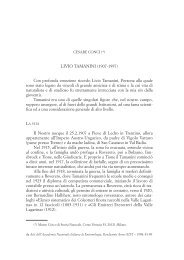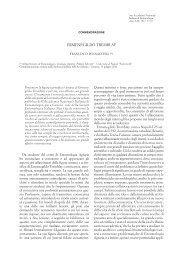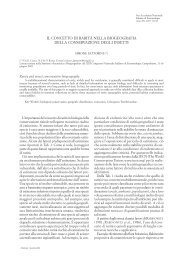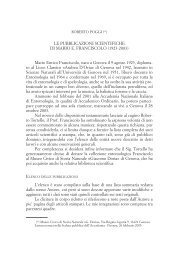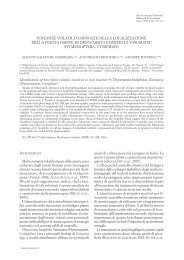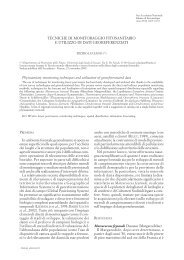XXII CNIE - Accademia nazionale italiana di Entomologia
XXII CNIE - Accademia nazionale italiana di Entomologia
XXII CNIE - Accademia nazionale italiana di Entomologia
You also want an ePaper? Increase the reach of your titles
YUMPU automatically turns print PDFs into web optimized ePapers that Google loves.
The optic lobes of Entomostraca consist of two neuropils only. The outer neuropil, called<br />
the lamina, derives from an outer cell proliferation zone. The lamina is linked by<br />
uncrossed axons to a plate- or tectum-like inner neuropil, whose neurons have very large<br />
dendritic fields and connect <strong>di</strong>rectly to premotor neurons in the brain. In contrast, the<br />
compound eyes of malacostracans and insects are served by four nested retinotopic<br />
neuropils. Three of these are linked by two successive chiasmata, whereas the fourth<br />
receives a system of uncrossed fibers. The first chiasma horizontally reverses in the<br />
second optic neuropil (the medulla) the order of retinotopic columns in the first optic<br />
neuropil (the lamina). The second chiasma carries retinotopic neurons from the medulla<br />
to a third neuropil (the lobula) where the horizontal order of columns is again reversed.<br />
Uncrossed axons from the medulla extend to a fourth neuropil, the plate-like lobula plate<br />
or, in some insects, a neuropil imme<strong>di</strong>ately under the lobula. Although the laminas of<br />
Entomostracan crustaceans (e.g. Artemia, Triops) have a retinotopic organization of<br />
photoreceptor en<strong>di</strong>ngs and second-order relay neurons that is similar to the laminas of<br />
other crustaceans and insects, at deeper levels the optic lobes of malacostracans and<br />
insects share multiple characters that are entirely absent from entomostracans. For<br />
example, many morphological types of neurons in the medullas of malacostracans have<br />
the same shapes and relative <strong>di</strong>spositions as in the medulla of insects (Strausfeld &<br />
Nässel 1980). Stu<strong>di</strong>ess of the growth of the lamina and medulla in insects describe both<br />
centers as arising orthogonally from two adjacent sets of precursor cells, called the outer<br />
optic anlagen (Meinertzhagen & Hanson 1993). In entomostracans, there is only one<br />
such set of precursors. In insects and malacostracans the medulla is likely to have<br />
originated from an ancestral duplication of the cell lineage originally provi<strong>di</strong>ng the<br />
entomostracan lamina (Meinertzhagen 1991). This means that the medulla is essentially<br />
the evolutionary progeny of the entomostracan lamina (Strausfeld 2005) and that the<br />
uncrossed axons exten<strong>di</strong>ng from it to the plate like fourth optic neuropil are homologous<br />
to the uncrossed axons exten<strong>di</strong>ng from the entomostracan lamina into its second optic<br />
neuropil. Thus, if insects have arisen from an entomostracan-like ancestor, then they and<br />
the malacostracans have independently evolved four optic neuropils and two chiasmata,<br />
as well as many cell types whose morphologies are almost in<strong>di</strong>stinguishable in these two<br />
groups.<br />
Not only do the Entomostraca lack two optic neuropils that are common to the<br />
malacostracans, but they also entirely lack any evidence of olfactory lobes. In contrast,<br />
both malacostracans and insects possess olfactory lobes served by homologous<br />
appendages, the antennules. These centers in the deutocerebrum are characterized by<br />
<strong>di</strong>screte subunits: glomeruli in insects, and columns in most malacostracans (the<br />
exceptions are the stomatopods and phyllocarids, both basal to the Malacostraca, in<br />
which olfactory lobes are also glomerular). A further commonality between basal<br />
malacostracans and insects is revealed by second-order projections from the olfactory<br />
lobes into the most rostral segment of the brain, the protocerebrum. In phyllocarids, relay<br />
neurons from the olfactory lobes project out to the lateral protocerebrum. The same<br />
occurs in the Archaeognatha, flightless ‘bristletails’ that are considered Mid-Devonian<br />
relics (Labandeira et al. 1988) and whose man<strong>di</strong>bles have only one point of articulation<br />
with the head capsule. These basal monocondylic insects, typified by the Machilidae,<br />
have projections from the olfactory lobes that similarly terminate in the lateral<br />
protocerebrum. In the Machilidae, as in phyllocarids and indeed all Malacostraca, these<br />
projections are <strong>di</strong>rect: they do not involve the mushroom bo<strong>di</strong>es because these centers<br />
are absent both in Malacostraca and the Machilidae (Strausfeld, 2009). Another likely<br />
ancestrally shared character (synapomorphy) of malacostracans and insects is that in the<br />
phyllocarids and machilids projections from the olfactory lobes to the protocerebrum are<br />
24



